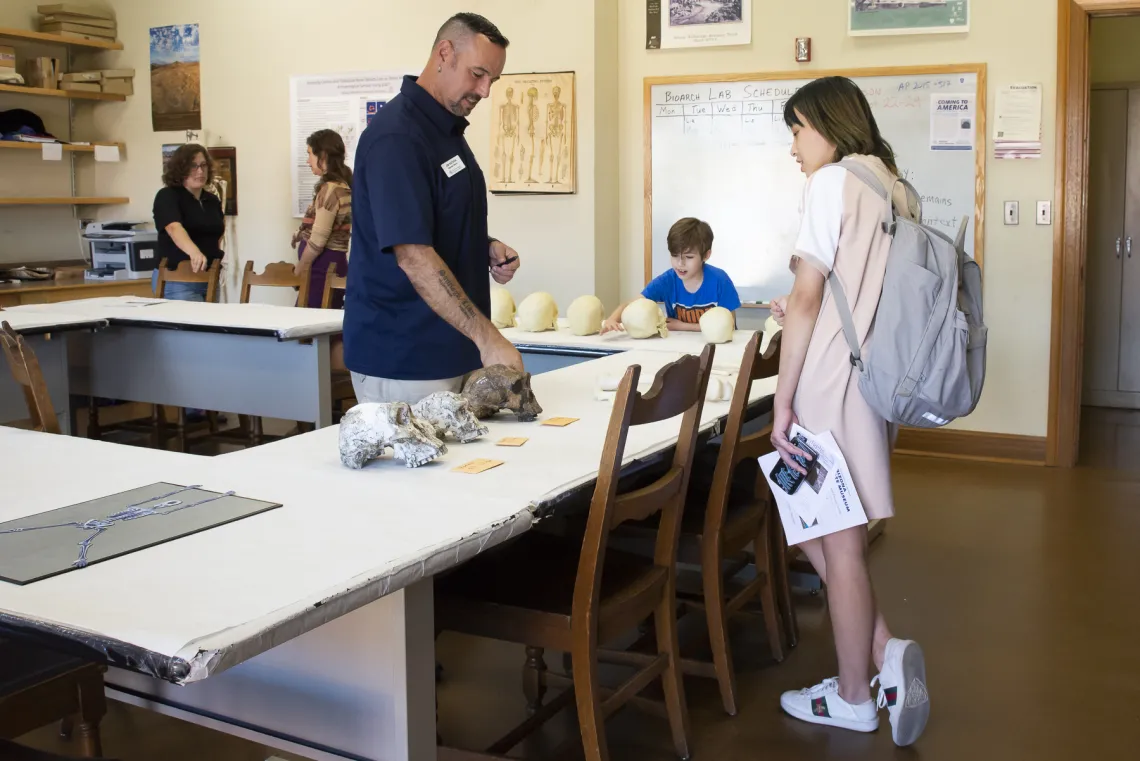ASM Bioarchaeology Lab

Associate Curator of Bioarchaeology Dr. James T. Watson welcomes students of all ages into ASM's human osteology laboratory (skulls shown are plastic models)
- The ASM Bioarchaeology Lab trains university students through classroom instruction, research, laboratory training, and field work.
- We provide professional services to public and private institutions across the state to facilitate compliance with state and federal laws regarding the recovery, documentation, treatment, and repatriation of human remains.
- We manage the preservation of human remains recovered from archaeological sites within the state and work closely with descendant communities to facilitate the return of ancestral remains under state and federal repatriation laws.
- We conduct research to reconstruct the lived experience of past populations.
Research
- La Playa Archaeological Project.
This is a long-term bi-national collaboration with the primary goal of investigating the archaeological site of La Playa, located in northern Sonora. La Playa is one of the earliest, largest settled villages in the Borderlands region of the Sonoran Desert primarily associated with the Early Agricultural (EA) period (2100 B.C.-A.D. 50), covering the transition from foraging to farming. Co-directed by Elisa Villalpando and John Carpenter at Centro INAH Sonora.
- Paleodietary Variability in the Americas.
The primary goal of this project is to better define how dietary adaptations to local environments play critical roles in the adoption and transition to reliance on domesticated plants and animals through our oral complex. We examine tooth wear across a wide variety of environmental, cultural, and temporal circumstances throughout the Americas to illuminate how these variables contribute to paleodietary variability.
- Proyecto Arqueológica Sur de Sonora
Driven by Principal Investigator Cristina Garcia Moreno (Centro INAH Sonora), the project focuses on the Prehispanic site of El Cemenetrio which is located adjacent to the Yaqui River in the valley of Ónavas, south-central Sonora, northwest Mexico. The site is a 2m-high burial mound containing 110 mortuary features dating between AD 897 and 1635 placing the site between the Middle and Late Ceramic periods (García M. and Watson 2017).
- Biology of Early Foragers on the Andean Altiplano.
This project examines human biology and the physical adaptations of the earliest full-time inhabitants of the Lake Titicaca Basin in Peru. This is a collaboration driven by Dr. Randy Haas and the Forager Complexity Lab at UC Davis (https://fcl.ucdavis.edu/).
Staff
Current Students
Past Students
|
Resources
Distinguishing Human From Non-Human Animal Bone
Note: this document contains photographs of human and animal remains.
Contact
James Watson, Ph.D.
Curator of Bioarchaeology
Arizona State Museum / University of Arizona
P.O. Box 210026
Tucson, AZ 85721-0026
520-621-4794
See Dr. Watson's Profile





